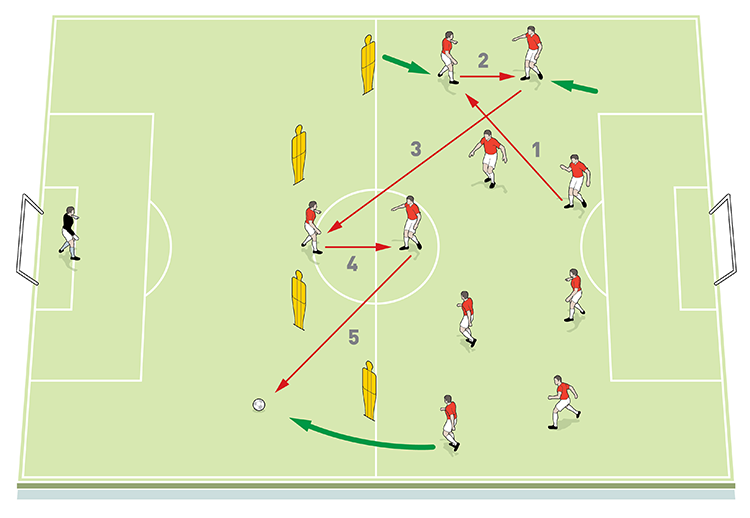Switch of play with counter-attack
Run this session when playing against teams who are going to attack directly – it works by allowing the opposition to come on to you before breaking quickly with a switch of play.

| Area | Use of a full pitch |
| Equipment | Balls, cones, mannequins |
| No. of Players | Up to 18 |
| Session Time | Phase One 15mins, Game situation 15mins |
In the modern game the switch of play is vital. Teams now play with a counter-attacking style where a rapid transition from one side of the pitch can immediately open up an attack against even the most organised opposition.
It’s important that your players are able to control a switch of play accurately and precisely, in order to make inroads to the opposition goal. Quick and accurate passing is required with speed of thought necessary from all team members. Communication and vision are vital as well, as is the speed from wide players in benefitting the team’s attacking power.
We would run this session when playing against teams who were going to attack us directly, allowing the opposition to come on to us before breaking quickly with a switch of play.
What do I get the players to do?
Phase One
We set up as shown on a 30x18-yard pitch, with mannequins positioned six yards in from the outside line (1) - both sides start at the same time with a ball each. We want to see various lengths of passes, with driven, side foot and lofted balls employed.
1

2. Player 2 controls and lays it back to player 1
3. Player 1 now sets the ball for player 3, who plays a diagonal pass to player 4 on the opposite side of the area
How do I progress the practice?
Once the players have mastered the basics we will move into a half-pitch, working towards one goal. Setting out our team in a 4-2-3-1 formation, this would now involve a crossing and finishing routine with a switch of play.
Taking the aspects from our first drill and now stretching the pitch, we make this game-related, as shown (2a/2b).
2a

2b

What are the key things to look out for?
The most important thing – at least, at first – is pass completion, otherwise the move has failed straight away. Players need to show good vision, speed of thought to see the switch of play and to execute it and, within that, positive forward runs from attackers. To that end, control and movement from the lone striker is important, as well as speed and drive from wide players to get behind their respective full-backs.
In terms of typical mistakes, we might see strikers not holding the ball up, or midfielders making misplaced passes. We also want to avoid a situation where wide players do not succeed in crossing beyond the front/near post, or otherwise fail to pick out a required midfielder or attacker because, ultimately, accuracy must be a key element in all of this.
For an extended game situation, we can move this into a full-sized pitch with waves of attackers, always looking for a switch of play and counter-attack.
More like this
Editor's Picks
Attacking transitions
Deep runs in the final third
Using the goalkeeper in build-up play
Intensive boxes drill with goals
Penetrating the final third
Creating and finishing
My philosophy
Pressing initiation
Compact team movement
Coaches' Testimonials

Alan Pardew

Arsène Wenger

Brendan Rodgers

Carlos Carvalhal

José Mourinho

Jürgen Klopp

Pep Guardiola

Roy Hodgson

Sir Alex Ferguson

Steven Gerrard
Coaches' Testimonials

Gerald Kearney, Downtown Las Vegas Soccer Club

Paul Butler, Florida, USA

Rick Shields, Springboro, USA

Tony Green, Pierrefonds Titans, Quebec, Canada
Join the world's leading coaches and managers and discover for yourself one of the best kept secrets in coaching. No other training tool on the planet is written or read by the calibre of names you’ll find in Elite Soccer.
In a recent survey 92% of subscribers said Elite Soccer makes them more confident, 89% said it makes them a more effective coach and 91% said it makes them more inspired.
Get Monthly Inspiration
All the latest techniques and approaches
Since 2010 Elite Soccer has given subscribers exclusive insight into the training ground practices of the world’s best coaches. Published in partnership with the League Managers Association we have unparalleled access to the leading lights in the English leagues, as well as a host of international managers.
Elite Soccer exclusively features sessions written by the coaches themselves. There are no observed sessions and no sessions “in the style of”, just first-hand advice delivered direct to you from the coach.









